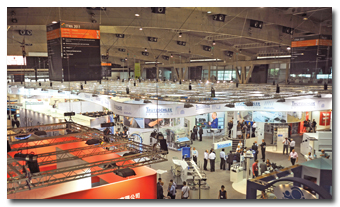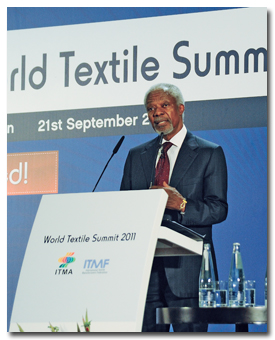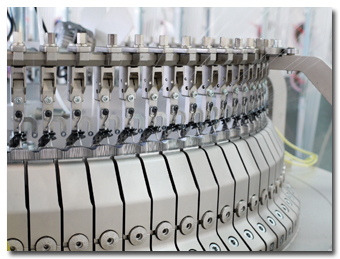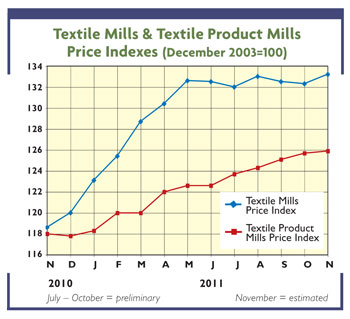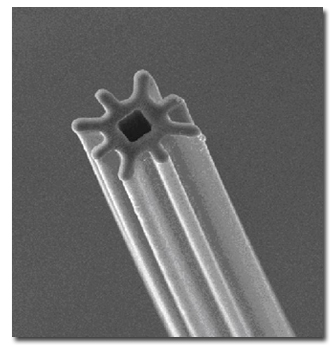ROSEVILLE, Minn. — October 26, 2011 — The Industrial Fabrics Association International (IFAI) 2011
International Achievement Awards (IAA) for design excellence in specialty fabrics applications
ceremony took place at IFAI Expo Americas 2011 at the Baltimore Convention Center in Baltimore, Md.
on October 25. The annual IFAI Expo Americas is the largest specialty fabrics trade show in
the Americas, and for more than six decades, IAA has recognized excellence in design and
innovation, highlighting truly spectacular work in the specialty fabrics industry.
Entrants were encouraged to submit projects and compete in 35 categories in this 64th
competition. In all, IFAI received 385 entries from 16 countries. Entries were judged by industry
experts, editors, architects, educators and design professionals, who were selected for their
knowledge in a particular field of study or product area. Winners were selected based on
complexity, design, workmanship, uniqueness and function.
IFAI encourages specialty fabric projects of all sizes and type. The goal of IAA is to
promote awareness of the specialty fabrics used in thousands of products and applications. All
entries receive prominent recognition at IFAI Expo Americas. Entrants receive additional publicity
through coverage in IFAI magazines, as well as press releases distributed to media
professionals.
The International Achievement Awards competition is sponsored by IFAI, a not-for-profit trade
association whose 2,000 member companies represent the international specialty fabrics marketplace.
The following is a complete list of award winners by category. Photos and detailed project
descriptions of the winners are available at
ifaipublications.com/iaa/.
Tensile Structures, Under 600 Square Meters (6458 Square Feet)
Award of Excellence
Fabritecture
Kingscliff, NSW, Australia
126: Eagle Street Pier, Brisbane
Outstanding Achievement Award
Fabric Architecture Ltd.
Gloucester, United Kingdom
102: Manchester City Football Stadium ‘Xtage’
Outstanding Achievement Award
Cidelsa
Lima, Peru
111: District Department of Environment
Outstanding Achievement Award
Oasis Tension Structures (Australia) Pty Ltd.
Melbourne, Australia
130: Melbourne Girls Grammar School
Tensile Structures, 600-2300 Square Meters (6458-24,756 Square Feet)
Award of Excellence
Cidelsa
Lima, Peru
211: Metro Uper Station
Outstanding Achievement Award
FTL Design Engineering Studio
New York, NY, United States
204: United Nations Interim Porte Cochere
Outstanding Achievement Award
Carpas Y Lonas El Carrousel S.A. de C.V.
Mexico City, Mexico
217: Tensostructure for Palacio De Mineria
Tensile Structures, More Than 2300 Square Meters (24,756 Square Feet)
Award of Excellence
Taiyo Europe GmbH
Sauerlach, Germany
304: Metro Mall Athens – Talima
Outstanding Achievement Award
Beijing N&L Fabric Technology Co., Ltd.
Beijing, China
314: Beijing Xi-er-qi Rapid Train Station
Outstanding Achievement Award
Cidelsa
Lima, Peru
315: Del Sol Metro Intermodal Station
Frame-Supported Structures
Award of Excellence
FabriTec Structures
Costa Mesa, CA, United States
408: Playa Vista Central Park Bandshell
Outstanding Achievement Award
Covertex Membranes (Shanghai) Co., Ltd.
Shanghai, China
403: German-Chinese House for 2010 Shanghai Expo
Outstanding Achievement Award
Hightex Group PLC
London, United Kingdom
404: Nouvelle Gare Beval-Usines
Air Structures
Award of Excellence
Lindstrand Technologies
Oswestry, United Kingdom
501: Helicopter Hangar (AS350)
Outstanding Achievement Award
Air Structures American Technologies Inc.
Rye Brook, NY, United States
504: Rutgers University
Commercial Awnings and Canopies, Less Than 112 Square Meters (1205 Square
Feet)
Award of Excellence
Canfab Products Ltd.
Edmonton, AB, Canada
618: Princess Florence Handbags
Award of Excellence
TensionStructures.com
Cerritos, CA, United States
616: Friendly Baptist Church
Outstanding Achievement Award
Carroll Awning Co.
Baltimore, MD, United States
601: Parkridge Office Building
Outstanding Achievement Award
Camel Custom Canvas Shop
Knoxville, TN, United States
607: Knoxville Opera
Outstanding Achievement Award
Miami Awning Co.
Miami, FL, United States
609: Bongos Cuban Cafe
Commercial Awnings and Canopies, More Than 112 Square Meters (1205 Square
Feet)
Award of Excellence
Port Douglas Sailmakers Pty Ltd.
Port Douglas, OLD, Australia
711: Airport Beer Garden Canopy
Outstanding Achievement Award
Carroll Awning Co.
Baltimore, MD, United States
702: Edenwald
Outstanding Achievement Award
MakMax Australia
Eagle Farm, OLD, Australia
708: Blacktown Village Green
Residential Awnings and Canopies, Less Than 112 Square Meters (1205 Square
Feet)
Award of Excellence
Awnings of Hollywood, Inc.
Hollywood, FL, United States
804: Curved BBQ Patio
Outstanding Achievement Award
House of Canvas
Ottawa, ON, Canada
806: Curved Canopy, Kanata
Outstanding Achievement Award
Premier Awnings
Costa Mesa, CA, United States
808: Patio System
Retractable Awnings and Canopies
Award of Excellence
Miami Awning Co.
Miami, FL, United States
1015: Cabana Beach Club at the Eden Roc Renaissance
Outstanding Achievement Award
BAT USA Corp.
Middletown, NY, United States
1008: 2040 in Montecarlo, France
Outstanding Achievement Award
Auvents OmbraSole
Montreal, QC, Canada
1010: Attico Awning
Tensioned Awnings and Canopies
Award of Excellence
TensionStructures.com
Cerritos, CA, United States
1108: St. Mary’s Academy
Outstanding Achievement Award
Eventstar Structures
Miami, FL, United States
1103: Dos Camino
Free-Standing Structures, Under 112 Square Meters (1205 Square Feet)
Award of Excellence
Shades (Thailand) Co., Ltd.
Phuket, Thailand
1204: Villa Sala
Outstanding Achievement
Canvas Specialty
Los Angeles, CA, United States
1205: Wave Cabana, Private Home
Outstanding Achievement
WeatherSafe WA
Bunbury, Australia
1206: Punmu Basketball Court Cover
Free-Standing Structures, More Than 112 Square Meters (1205 Square Feet)
Award of Excellence
Fabritecture
Kingscliff, NSW, Australia
1307: Soul Surfers Paradise, Australia
Outstanding Achievement Award
Fabric Architecture Ltd.
Gloucester, United Kingdom
1308: Manchester City Football Club Fan Pavilion
Outstanding Achievement Award
Carpas Y Lonas El Carrousel S.A. de C.V.
Mexico City, Mexico
1306: Bamboo Pavilion
Exterior Shades and Screens
Award of Excellence
Sunmaster of Naples, Inc.
Naples, FL, United States
1404: Minyard Built-In Retractable Screens
Outstanding Achievement Award
Lake Gaston Awning
Bracey, VA, United States
1410: Flip Up Shade
Outstanding Achievement Award
BAT USA Corp.
Middletown, NY, United States
1415: Gennius A2 Lake of Garda
Multiple Modular Structures
Award of Excellence
Fabric Architecture Ltd.
Gloucester, United Kingdom
1502: The Canopies at Dogs Trust
Fabric Graphics
Award of Excellence
Rainier Industries
Tukwila, WA, United States
1607: The Experience Music Project Nirvana Exhibit
Outstanding Achievement Award
Eventscape Inc.
Toronto, ON, Canada
1606: Discovery Place
Fabric Art
Award of Excellence
Fabric Structure Systems
Whangarei, New Zealand
1716: Pou Manawa
Outstanding Achievement Award
MakMax Australia
Eagle Farm, OLD, Australia
1707: Trailfinders Australian Garden Presented by Flemings’
Outstanding Achievement Award
Transformit
Gorham, ME, United States
1714: Installation Art and Wayfinding at Discovery Parks Vancouver
Marine Powerboat Covers
Award of Excellence
Nautilux Custom Canvas LLC
Hazlet, NJ, United States
1834: Lonely Tiara
Outstanding Achievement Award
Marine Concepts
Lees Summit, MO, United States
1830: 43 Dragon
Marine Powerboat Tops – Soft Enclosures
Award of Excellence
Corrado’s Canvas & Cushions
Bristol, RI, United States
1939: Rendering to Reality
Outstanding Achievement Award
Bennett Custom Canvas Inc.
Toronto, ON, Canada
1942: Searay 40 Sundancer
Marine Powerboat Tops – Hard Enclosures
Award of Excellence
Bev’s Canvas Covers
Waterford, MI, United States
2024: Camouflaged Duck Boat
Outstanding Achievement Award
SeaCanvas
Egg Harbor Township, NJ, United States
2028: Some Rigid/Some Soft
Marine Upholstery
Award of Excellence
Paul’s Custom Canvas, Inc.
Denver, CO, United States
2139: 32 Fountain
Outstanding Achievement Award
JSI/ Island Nautical
St. Petersburg, FL, United States
2136: Cool Cat
Outstanding Achievement Award
Paul’s Custom Canvas, Inc.
Denver, CO, United States
2140: Starcraft Pontoon
Outstanding Achievement Award
Custom Canvas of Charleston
N. Charleston, SC, United States
2142: 190′ Perini Navi Exterior
Marine Sailboats
Award of Excellence
Iverson’s Design
Olympia, WA, United States
2235: Sleek Enclosure Design
Outstanding Achievement Award
Iverson’s Design
Olympia, WA, United States
2238: Galetea Make Over Project
Outstanding Achievement Award
Bennett Custom Canvas Inc.
Toronto, ON, Canada
2240: Catalina 34
Party Tent Rental, Less Than 300 Meters Square (3229 Square Feet)
Award of Excellence
Mahaffey Fabric Structures
Memphis, TN, United States
2302: A Southern Kind of Wedding
Party Tent Rental, More Than 300 Meters Square (3229 Square Feet)
Award of Excellence
EventQuip
Lansdale, PA, United States
2402: National Museum of American Jewish History
Outstanding Achievement Award
Chattanooga Tent Co.
Chattanooga, TN, United States
2405: White Wedding
Tent Rental, More Than 300 Meters Square (3229 Square Feet)
Award of Excellence
JK Rentals, Inc.
Kewaskum, WI, United States
2609: Cruise Ship Tenting
Outstanding Achievement Award
ROEDER Zelt-und Veranstaltungsservice GmbH
Buedingen, Germany
2602: BMW International Open Munich
Tent Manufacturing and Design
Award of Excellence
The SEC Group
Wilsonville, OR, United States
2713: Main Stage Venue for Bard on the Beach Shakespeare Festival
Outstanding Achievement Award
Eventstar Structures
Miami, FL, United States
2715: Design Miami 2010
Outstanding Achievement Award
Roder HTS Hocker GmbH
Kefenrod, Germany
2719: The Absolute Structure
Interior Display
Award of Excellence
Moss Inc.
Elk Grove Village, IL, United States
2813: MTV Video Music Awards Stage Set
Outstanding Achievement Award
Pink Powered by Moss
New York, NY, United States
2803: The PowerStation
Outstanding Achievement Award
Lawrence Fabric & Metal Structures, Inc.
St. Louis, MO, United States
2809: Schick Trade Show Exhibit
Commercial Interiors
Award of Excellence
Fabric Architecture Ltd.
Gloucester, United Kingdom
2904: Dublin Airport Terminal 2
Outstanding Achievement Award
Transformit
Gorham, ME, United States
2905: Daylighting Diffusers at the North Carolina Museum of Art
Geosynthetic Projects
Award of Excellence
TenCate Geosynthetics
Pendergrass, GA, United States
3001: Geotextile Reinforced Soil Retaining Wall for Hetaoyu Mine Coal Processing Plant
Outstanding Achievement
Agru America, Inc.
Georgetown, SC, United States
3008: Timber Ridge Landfill Closure
Outstanding Achievement
ACE Geosynthetics
Taichung Hsien, Taiwan, Province of China
3011: Application of Complex Reinforced Structure Near Fault Zone
Auto and Transportation Upholstery
Award of Excellence
CYA Canvas
Helena, MT, United States
3128: Distance Dogsled Bag
Outstanding Achievement Award
Moonlight Upholstery
Saginaw, MI, United States
3125: 1967 El Camino
Residential Upholstery
Award of Excellence
Kipe’s Upholstery
Hagerstown, MD, United States
3209: Black & White Chair
Outstanding Achievement Award
Buckminster Upholstery
Falls City, NE, United States
3204: 1945 Deco
Safety and Technical Projects
Award of Excellence
A&R Tarpaulins, Inc.
Fontana, CA, United States
3402: Fabric Engine Ventilation Covers
Outstanding Achievement Award
Shelter Structures, Inc.
Phladelphia, PA, United States
3401: NASA Michoud Assembly Faciilty
Miscellaneous
Award of Excellence
Lindstrand Technologies
Oswestry, United Kingdom
3529: Delhi Aerostat
Outstanding Achievement Award
Canvasland Holdings Ltd.
Levin, New Zealand
3521: Waikato Museum T-Rex
Outstanding Achievement Award
Daniel Slota
Berlin, Germany
3526: Obervation Tower Teichland
Posted on November 30, 2011
Source: IFAI

